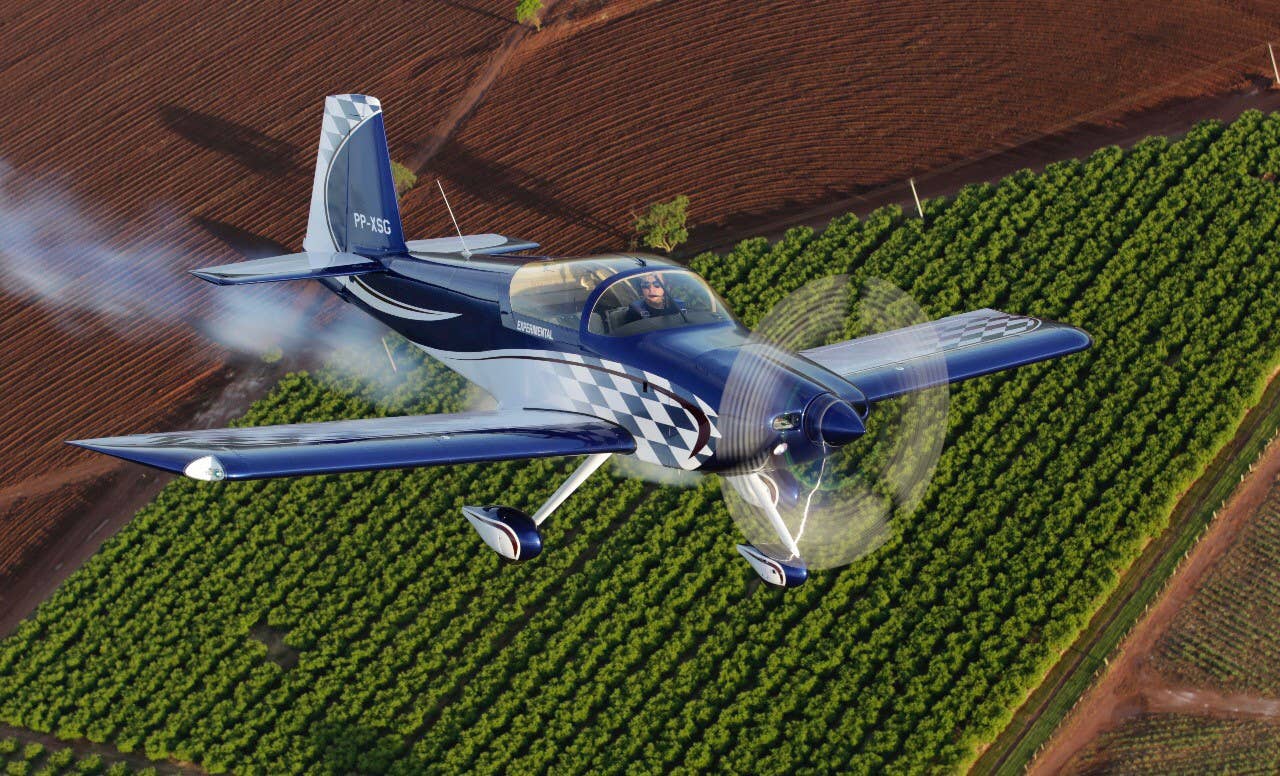
The Van’s RV-7s are designed to be operated in both aerobatic and normal category (aircraft in photo is not the accident airplane). Josue de Andrade/Van’s Aircraft
The Civil Aviation Authority of New Zealand says an amateur built Van’s Aircraft RV-7 broke up in midair during a January 1, 2018, VFR flight, killing the pilot and passenger. The CAA believes the pilot lost control of the aircraft after possibly conducting an aerobatic maneuver that far exceeded the RV-7′s never-exceed speed (VNE). The aircraft had departed Whangarei aerodrome—about 60 miles north of Auckland—at about midday.
The CAA said at about 12:16 local time, the RV-7′s EFIS recorded the aircraft in a steep 70-degree left bank with a nine-degree nose-down pitch. The airspeed was recorded as 148 knots. RV-7 aircraft are designed to be operated in both aerobatic and normal categories. After a short descent, the aircraft returned to its initial altitude of 4,500 feet. A minute later, the EFIS recorded that the aircraft had entered a 70-degree right bank with a nose-up pitch of 20 degrees, while the airspeed had dropped to 132 knots. A few seconds later the bank angle increased to 130 degrees with a 20-degree nose-down pitch.
At 12:17:13, the nose pitched down further to 60 degrees with the aircraft in an approximately 60-degree right-bank as the airspeed climbed to 183 knots. Six seconds later, the RV-7′s nose dropped to 30 degrees below the horizon as the airspeed rocketed to 244 knots. The RV-7′s never-exceed speed is approximately 200 knots. Four seconds later the aircraft rolled into a 40-degree right bank with a 30-degree nose-down pitch and an airspeed of 99 knots. Shortly thereafter, the RV-7 broke up in flight and later impacted local terrain.
The pilot held a private pilot-airplane certificate and an ATPL for helicopters with an instrument rating. Anecdotal evidence gathered by the CAA indicated the pilot enjoyed flying around clouds and on the day of the accident some clouds were present at and below the altitudes at which the aircraft was operated. Whether this was a joy-ride flight to show off, a pilot practicing aerobatics or some sort of inadvertent encounter with weather was never determined. The CAA learned the pilot did not hold an aerobatic rating, which requires a special course of training in New Zealand. Witnesses said the pilot did not like to conduct aerobatics and that he was generally a “straight and level” pilot who would “climb to seek smoother air,” when required.
The safety investigation could not conclusively determine if the aircraft inadvertently entered cloud during one of its maneuvers. If, however, an inadvertent IMC encounter did occur, it is possible the pilot experienced spatial disorientation, leading to the aircraft entering an unusual attitude. The CAA said they also could not determine from the physical evidence, who was in control of the aircraft when the in-flight breakup occurred. Witnesses said it was not a general practice for the pilot to relinquish control of the aircraft to passengers during flights.
From the evidence available, safety investigators learned the pilot had not conducted steep turns of 70 degrees before the accident flight. The CAA also believed it was possible the pilot became startled at the aircraft’s behavior and misapplied some flight control movements that were appropriate to helicopters in order to recover from the steep bank and dive he encountered.
The CAA said the vertical stabilizer and top half of the rudder were located approximately 2,000 feet south-east of the main wreckage site, while the right wing was located approximately 1,500 feet south-east of the main wreckage. The top half of the rudder was still attached to the vertical stabilizer at the top and center hinges but had fractured in half just below the center hinge. The rudder had split open at the trailing edge riveted joint, fractures consistent with overstress. However there were no indications of progressive failure. Numerous parts of the rudder, including the rudder balance weight and lower skin section, had separated from the main rudder structure and were considered consistent with rudder flutter.
During this investigation, the CAA worked with both the US NTSB and the Transport Safety Board of Canada to identify RV-7 accidents with similar wreckage signatures to the accident airplane. One RV-7A accident occurred in the United States, the other in Canada. In both accidents, the damage to the rudder structure and the separation of the vertical stabilizer was determined to be consistent with rudder flutter leading to structural failure of the vertical stabilizer attachment points. An NTSB report stated, “Failure of the horizontal tail first would cause the airplane to pitch down rapidly, producing air loads on the upper surface of the wing that were sufficient to fail them in negative overload.” The damage to the right wing of the accident aircraft was consistent with a downward failure in negative overload.
The CAA did not assign a probable cause to this accident, saying only that, “Accidents can occur whenever the aircraft limitations and or the pilot’s own capabilities are exceeded.”

Sign-up for newsletters & special offers!
Get the latest FLYING stories & special offers delivered directly to your inbox






